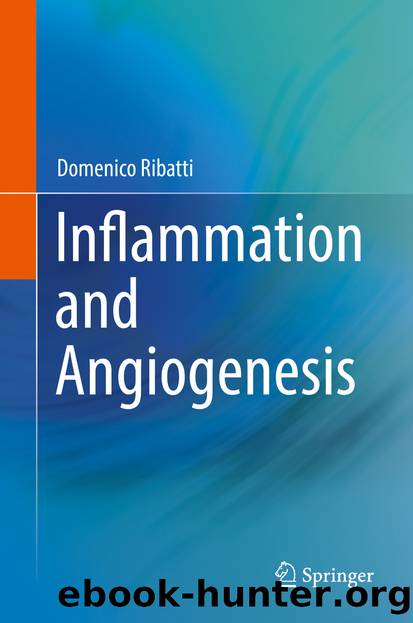Inflammation and Angiogenesis by Domenico Ribatti

Author:Domenico Ribatti
Language: eng
Format: epub
Publisher: Springer International Publishing, Cham
7.11 Fibroblasts
In the specific context of solid tumors, fibroblasts are referred as cancer associated fibroblasts (CAFs) or tumor associated fibroblasts (TAFs) and exhibit some similarities with myofibroblasts, originally characterized in wound healing and fibrosis (Gabbiani et al. 1971; Madar et al. 2013). In breast, prostate, and pancreatic carcinomas, CAFs parallel higher malignancy grade, tumor progression, and poor prognosis (Kalluru and Zeisberg 2006; Franco et al. 2010; Orimoa and Weinberg 2006; Shimoda et al. 2010. In mouse xenografts, CAFs inoculated with carcinoma cells promote tumor survival, proliferation and invasive behaviour (Erez et al. 2010; Orimo et al. 2005).
The definition of CAFs encompasses a few important features: (i) these fibroblasts are in close contact with cancer cells, (ii) CAFs display peculiar immunophenotypic and functional features that sharply differentiate them from normal, resting fibroblasts located in non-neoplastic environments, and (iii) the properties acquired by CAFs upon interaction with cancer cells render them supportive of tumor growth and progression through different mechanisms including extracellular matrix remodelling, cell proliferation, angiogenesis and epithelial mesenchymal transition (EMT) (Cirri and Chiarugi 2012).
CAF activation is commonly accompanied by the acquisition or upregulation of specific markers which can be classified in four groups: (i) the fibroblast activation markers, which include fibroblast specific protein (FSP) and fibroblast activation protein (FAP); (ii) the aggressiveness markers thrombospondin-1 (TSP-1), tenascin-C and stromelysin; (iii) the pro-angiogenic markers (desmin-1, FGF-2, alpha smooth-muscle-actin (α-SMA) and VEGF); and (iv) the growth factors that support tumor growth and inflammation (EGF, HGF, IL-6, FGF-2 (Cirri and Chiarugi 2012; Räsänen and Vaheri 2010). Moreover, CAFs express MMP1, MMP-3, produce collagens, and release cytokines and pro-angiogenic growth factors (Kopp et al. 2005), including VEGF, HGF, FGF-2, Ang-1, IL-6, IL-8, MCP-1, identified within in vitro secretome of adult tissue-derived MSCs (Chen et al. 2008). CAFs are a major source of VEGF in transgenic mice (Fukumura et al. 1998), and CAF-derived VEGF enhances the expression and activation of integrins (Byzova et al. 2000). CAF-derived PDGF sustains angiogenesis by further stimulating CAFs to secrete pro-angiogenic growth factors, including FGF-2 and osteopontin (Pietras et al. 2008; Anderberg et al. 2009).
CAFs release angiogenic factors through proteolysis of the extracellular matrix. In this respect, CAFs localized in invasive human breast carcinomas promote tumor growth and angiogenesis through elevated Stromal-Derived-factor-1 (SDF-1)/CXCL12 secretion (Orimo et al. 2005).
Co-implantation of CAFs and cancer cells enhances angiogenesis, decreases cancer cell dormancy and accelerates tumor growth in mice (Tuxhorn et al. 2002; Orimo et al. 2005).
The heterogeneity in marker expression led to hypothesize that CAFs could have multiple origins, depending on the tumor histotype and the area of the neoplastic lesion (De Wever et al. 2014). Indeed, it is becoming evident that CAFs originate from local or distant reservoirs through different types of trans differentiation processes.
The primary source of CAFs is represented by resident fibroblast or pericytes which trans differentiate through a mesenchymal-mesenchymal transition (MMT) driven by specific cancer-derived factors such as TGF-β, PDGF, FGF-2, and SDF-1 (Fig. 7.24) (Cirri and Chiarugi 2011; Kojima et al. 2010). In addition, CAFs may originate from local
Download
This site does not store any files on its server. We only index and link to content provided by other sites. Please contact the content providers to delete copyright contents if any and email us, we'll remove relevant links or contents immediately.
| Administration & Medicine Economics | Allied Health Professions |
| Basic Sciences | Dentistry |
| History | Medical Informatics |
| Medicine | Nursing |
| Pharmacology | Psychology |
| Research | Veterinary Medicine |
Dynamic Alignment Through Imagery by Eric Franklin(4121)
Body Love by Kelly LeVeque(3017)
Barron's AP Calculus by David Bock(1780)
EMT Exam For Dummies with Online Practice by Arthur Hsieh(1654)
The Juice Lady's Remedies for Asthma and Allergies by Cherie Calbom(1608)
Fitness Walking For Dummies by Liz Neporent(1532)
Flight by Elephant(1487)
Extremes: Life, Death and the Limits of the Human Body by Fong Kevin(1485)
McGraw-Hill Nurses Drug Handbook by Patricia Schull(1466)
The Natural First Aid Handbook by Brigitte Mars(1434)
Tell by Major Margaret Witt(1382)
Skin by Unknown(1373)
Seeing Voices by Oliver Sacks(1362)
Born to Walk by James Earls(1284)
The Yoga Bible by Christina Brown(1267)
Cracking the Nursing Interview by Jim Keogh(1254)
First Aid for Colleges and Universities (10th Edition) by Mistovich Joseph J. & Limmer Daniel J. & Karren Keith J. & Hafen Brent Q(1233)
The Advantage by Lencioni Patrick M(1173)
Living Ready Pocket Manual - First Aid: Fundamentals for Survival by James Hubbard(1163)
